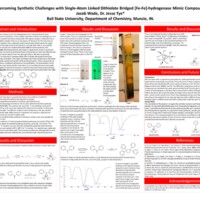Browse Exhibits (1 total)
Jacob Wade | Overcoming Synthetic Challenges with Single-Atom Linked Dithiolate Bridged [Fe-Fe]-hydrogenase Mimic Compounds

Due to their high catalytic turnover frequency, [Fe-Fe]-hydrogenase mimic compounds have been suggested as potential replacements for platinum in the catalytic reduction of water into hydrogen for fuel cells which has fueled significant research into these compounds. The natural enzyme is believed to be a three-atom azadithiolate (adt) linked complex. There is an abundance of literature for the two-atom or larger linked mimic compounds, however only a relatively small amount exists which covers the single-atom linked compounds. Through thorough study of the literature, we have been able to successfully synthesize two single atom linked compounds: methanedithiolate (mdt) diironhexacarbonyl and diphenylmethanedithiolate (dpmdt) diironhexacarbonyl, with hopes to apply these routes to synthesize novel compounds. Though we have successfully synthesized these compounds, we have had difficulty with purifying them, always obtaining impure material from the silica gel column. We have successfully replicated the synthesis of these compounds in adequate yields with multiple side-products but have received inconsistent results during purification. One major challenge with these compounds is that these compounds are extremely non-polar, quickly eluting with 100% pentane/hexanes. These compounds are highly soluble in these solvents which complicates attempts at recrystallization. The presentation herein highlights the challenges which we have faced, and the steps taken to successfully synthesize and purify these compounds and plans to apply the learned techniques to synthesizing novel compounds including: di-2-pyridylmethanedithiolate (dpymdt) diironhexacarbonyl and the nitrogen based aminodithiolate (ndt) diironhexacarbonyl.
Faculty Mentor: Dr. Jesse Tye
Chemistry
Graduate
